Reminiscing


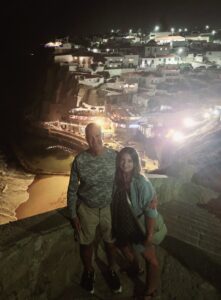 For my niece, Toni Chase and her husband, Dave, travel is always on the agenda. They always have several trips to various places, some of which are quite exotic. Tonie tells me that this was “a very good year.” Over the Independence Day week, Toni and Dave took a trip to Glacier National Park with their son, James Renville and his wife Manuela…and of course, Toni and Dave’s puppies, Biscuit and Cricket. They all had an amazing time. They love doing a little hiking and exploring the lakes and rivers in the area. Later, Toni and Dave took a trip to New Mexico with his mom and sister. One of the highlights of the trip was the trip to White Rock overlooking the Rio Grande River. The view was majestic, and they absolutely loved the time together.
For my niece, Toni Chase and her husband, Dave, travel is always on the agenda. They always have several trips to various places, some of which are quite exotic. Tonie tells me that this was “a very good year.” Over the Independence Day week, Toni and Dave took a trip to Glacier National Park with their son, James Renville and his wife Manuela…and of course, Toni and Dave’s puppies, Biscuit and Cricket. They all had an amazing time. They love doing a little hiking and exploring the lakes and rivers in the area. Later, Toni and Dave took a trip to New Mexico with his mom and sister. One of the highlights of the trip was the trip to White Rock overlooking the Rio Grande River. The view was majestic, and they absolutely loved the time together.
While the trips to Glacier and New Mexico were amazing, the trip that was the crème de la crème was the trip 
 they took to Portugal. Dave had wanted them to take this trip for their tenth wedding anniversary, but Covid-19 rather got in the way, so they finally took the trip in September. The had a wonderful time, seeing all the sights and dining in all the best places. On the first night there, Toni had shrimp, and Dave took a picture of her plate to send as a joke to her son James. How the shrimp ended up with a face of sorts, I do not know. They took lots of pictures so that they will have great memories of this trip of a lifetime.
they took to Portugal. Dave had wanted them to take this trip for their tenth wedding anniversary, but Covid-19 rather got in the way, so they finally took the trip in September. The had a wonderful time, seeing all the sights and dining in all the best places. On the first night there, Toni had shrimp, and Dave took a picture of her plate to send as a joke to her son James. How the shrimp ended up with a face of sorts, I do not know. They took lots of pictures so that they will have great memories of this trip of a lifetime.
Toni and Dave also went to a couple of concerts this year. One was an outdoor concert, and the other was at Dropkick Murphy’s. The kids went to that one too. The concerts and trips were a welcome break from the renovations they have been working on in their rental house. The house has been sold now to James and Manuela, and James is especially excited about that, as it is the house he grew up in. Toni tells me that she 
 spent just about every free second she had all winter and clear up to August working on that house getting it ready to sell to James and Manuela. The house didn’t have a lot of issues, but it was built in the 1950s, and as with any older home, things need to be repaired, updated, and modernized. All in all, it has been a busy year. Today is Toni’s birthday. Happy birthday Toni!! Have a great day!! We love you!!
spent just about every free second she had all winter and clear up to August working on that house getting it ready to sell to James and Manuela. The house didn’t have a lot of issues, but it was built in the 1950s, and as with any older home, things need to be repaired, updated, and modernized. All in all, it has been a busy year. Today is Toni’s birthday. Happy birthday Toni!! Have a great day!! We love you!!
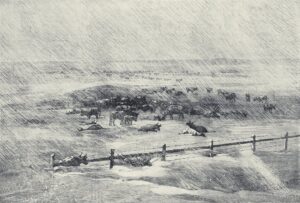
 Many people hate, or at least really dislike winter, but the cold and snow we normally see really isn’t so bad…at least not when compared to “the worst winter in the West,” which took place in 1886. During one of the harshest days of the “worst winter in the West,” nearly an inch of snow fell every hour for 16 hours, placing increased stress on the already starving cattle’s ability to find food.
Many people hate, or at least really dislike winter, but the cold and snow we normally see really isn’t so bad…at least not when compared to “the worst winter in the West,” which took place in 1886. During one of the harshest days of the “worst winter in the West,” nearly an inch of snow fell every hour for 16 hours, placing increased stress on the already starving cattle’s ability to find food.
Harsh winters in Montana, Wyoming, and the Dakotas was nothing new, but underestimating the coming winter can lead to disaster. The plains ranchers had seen severe winters in the past, but they had survived because their cattle were well-fed into the winter. By the mid-1880s, however, the situation had changed, and the winters had become mild. In hopes of making quick and easy money, greedy speculators had stocked the northern ranges in Montana, Wyoming, and the Dakotas. Deceived by the prior series of mild winters, many ranch managers had stopped putting up any winter feed. Then, in 1886, disaster struck.
The disaster began when that summer was hot and dry. Draught is often a precursor to big problems. By autumn, the range was almost barren of grass. That was bad enough, but then came the cold and snow, which came early. By January, record-breaking snowfalls blanketed the plains, forcing the already weakened cattle to expend vital energy just moving through the snow in search of the already scant forage. In January, a warm Chinook wind briefly melted the top layers of snow. The “January Thaw” is a well know phenomenon is this area. When the brutal cold returned…so brutal, that some ranches recorded temperatures of 63 below zero, a hard, thick shell of ice formed over the ground, making it almost impossible for the cattle to break through the snow to reach the meager amount of grass below. Unfortunately, the ranchers had become complacent, and with no winter hay stored to feed the animals, many ranchers had to sit by idly and watch their herds slowly starve to death. According to one historian, “Starving cattle staggered through village streets, and collapsed and died in dooryards.” In Montana, 5,000 head of cattle invaded the outskirts of Great Falls, eating the saplings the townspeople had planted that spring and “bawling for food.”
When the snow melted in the spring, the carcasses of the massive herds dotted the land as far as the eye could see. One observer noted that many rotting carcasses clogged the creeks and rivers, so that it was difficult to find water fit to drink. Millions of cattle are estimated to have died during the “Great Die-Up,” in a grimly humorous reference to the celebrated “Round-Up.” Montana ranchers alone lost an estimated 362,000 head of cattle, which was more than half of the territory’s herd.
The ill planned for disaster sent hundreds of area ranches into bankruptcy. The hard winter also brought an abrupt end to the era of the open range. Realizing that they could not predict future weather, the ranchers now understood that they would always need to grow crops to feed their animals, both in summer and winter. Ranchers began to reduce the size of their herds and to stretch barbed wire fences across the open range to 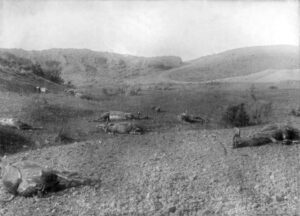
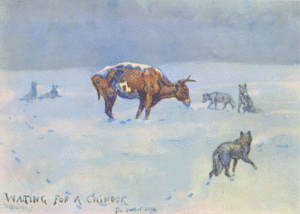 enclose their new hay fields. By the 1890s, the typical rancher was, out of necessity, also a farmer. Cowboys began to spend more time fixing fences than riding herd or roping yearlings. Hard lessons learned, but eventually, new settlers to the West understood that they had to adapt to the often-harsh demands of life on the western plains, if they were to survive and thrive.
enclose their new hay fields. By the 1890s, the typical rancher was, out of necessity, also a farmer. Cowboys began to spend more time fixing fences than riding herd or roping yearlings. Hard lessons learned, but eventually, new settlers to the West understood that they had to adapt to the often-harsh demands of life on the western plains, if they were to survive and thrive.
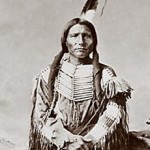
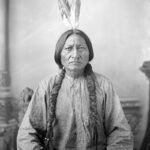 When the US government decided that the Indians in Montana needed to be moved to their reservations, they resisted by gathering together a combined force of Sioux and Cheyenne warriors and in what became known as the Battle of the Little Bighorn, Crazy Horse and his ally, Sitting Bull along with their men fought to a stunning victory over Lieutenant Colonel George Custer (1839-1876) and his men. Custer faced fierce resistance from Native Americans who opposed the strenuously opposed the US government’s efforts to force them back to their reservations. After Custer and over 200 of his soldiers were killed in the conflict, later dubbed “Custer’s Last Stand,” the white American public demanded revenge. Consequently, the US Army, led by General Nelson Miles (1839-1925), launched a winter campaign in 1876-1877 against the remaining tribes on the Northern Plains.
When the US government decided that the Indians in Montana needed to be moved to their reservations, they resisted by gathering together a combined force of Sioux and Cheyenne warriors and in what became known as the Battle of the Little Bighorn, Crazy Horse and his ally, Sitting Bull along with their men fought to a stunning victory over Lieutenant Colonel George Custer (1839-1876) and his men. Custer faced fierce resistance from Native Americans who opposed the strenuously opposed the US government’s efforts to force them back to their reservations. After Custer and over 200 of his soldiers were killed in the conflict, later dubbed “Custer’s Last Stand,” the white American public demanded revenge. Consequently, the US Army, led by General Nelson Miles (1839-1925), launched a winter campaign in 1876-1877 against the remaining tribes on the Northern Plains.
By combining military force with diplomatic efforts, Nelson persuaded many Native Americans to surrender and return to their reservations. However, much to Miles’ frustration, Sitting Bull refused to capitulate and fled to Canada, where he and his people remained for four years before finally surrendering to the US in 1881. Sitting Bull died in 1890. Meanwhile, Crazy Horse and his band also refused to surrender, despite suffering from illness and starvation.
Six months later, Oglala Lakota Sioux warrior Crazy Horse and his men, who were severely outnumbered, low on ammunition, and forced to use outdated weapons to defend themselves, began the fight that would in essence become Crazy Horse’s Last Stand…or at least his final losing battle against the US Cavalry in Montana. On January 8, 1877, General Miles discovered Crazy Horse’s camp along Montana’s Tongue River. US soldiers opened fire with their large wagon-mounted guns, forcing the Native Americans from their warm tents into a raging blizzard. Crazy Horse and his warriors managed to regroup on a ridge and fire, but most of their ammunition was gone, leaving them to fight with bows and arrows. They held off the soldiers long enough for the women and children to escape under the cover the blinding blizzard before they turned to go with them.
Although Crazy Horse had avoided a decisive defeat, opting instead to retreat, he understood that Miles and his 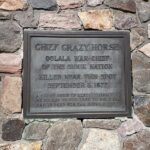
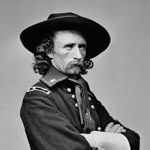 well-equipped cavalry troops would eventually hunt down and destroy his cold, hungry followers. On May 6, 1877, Crazy Horse led approximately 1,100 Native Americans to the Red Cloud reservation near Nebraska’s Fort Robinson and surrendered. Five months later, a guard fatally stabbed him after he allegedly resisted imprisonment by the guards. Very few people believe that story, since it was Crazy Horse who had chosen to surrender. During that time there was a deep level of discord between the Native Americans and the White Man. I’m sure the guard felt that he was doing everyone a favor.
well-equipped cavalry troops would eventually hunt down and destroy his cold, hungry followers. On May 6, 1877, Crazy Horse led approximately 1,100 Native Americans to the Red Cloud reservation near Nebraska’s Fort Robinson and surrendered. Five months later, a guard fatally stabbed him after he allegedly resisted imprisonment by the guards. Very few people believe that story, since it was Crazy Horse who had chosen to surrender. During that time there was a deep level of discord between the Native Americans and the White Man. I’m sure the guard felt that he was doing everyone a favor.

 This year has been one of great change and excitement for my grandniece, Siara Kirk. Just after her last birthday, her son Nathan was born, and while she still misses her first son, Alec Olsen, who passed away at three months old, in 2020, she has been so excited to have spent such a wonderful year with Nathan. Siara and her husband, Chris Kirk spent several months before Nathan’s arrival remodeling their newly purchased house so that everything would be perfect for their new little bundle of joy. And Nathan has not disappointed them. He has kept them laughing, hugging, and smothering him with kisses.
This year has been one of great change and excitement for my grandniece, Siara Kirk. Just after her last birthday, her son Nathan was born, and while she still misses her first son, Alec Olsen, who passed away at three months old, in 2020, she has been so excited to have spent such a wonderful year with Nathan. Siara and her husband, Chris Kirk spent several months before Nathan’s arrival remodeling their newly purchased house so that everything would be perfect for their new little bundle of joy. And Nathan has not disappointed them. He has kept them laughing, hugging, and smothering him with kisses.
Siara works at Platte Valley Bank in Casper, and since they bought the house next door to her parents, Chantel and Dave Balcerzak, she has an easy childcare situation that is a blessing to her and Chris, as well as the 
 grandparents. Siara and Chris are wonderful parents, and Nathan is such a goofy, happy little boy. These days he is keeping them on their toes, because he is everywhere all at once…typical of little one year old boys. Siara doesn’t mind that one bit, she is just enjoying the thrill of motherhood…and it keeps her in great shape…a win-win!!
grandparents. Siara and Chris are wonderful parents, and Nathan is such a goofy, happy little boy. These days he is keeping them on their toes, because he is everywhere all at once…typical of little one year old boys. Siara doesn’t mind that one bit, she is just enjoying the thrill of motherhood…and it keeps her in great shape…a win-win!!
Siara and Chris have always been active people. They love to be outdoors and go hiking. They have also been going snowboarding. This is a new sport for Siara, and she is enjoying it very much. They also love going to the lake and hanging out in the sun. I know that little Nathan will be an outdoor baby too, because he will want to be just like his parents. Siara and Chris love to attend concerts and football games too…often with her parents. 
 They are avid Wyoming Cowboys fans, as is most of our family, and they try to get to as many games as they can. Siara has always been a football fan, or at least since her cheerleading days at Kelly Walsh High School and the University of Great Falls. Siara is a National Champion Cheerleader from her days at Kelly Walsh, and that is an honor that will always be with her. Being athletic is such an important thing. It keeps us healthy, and that is a great thing to pass on to our kids. Siara will leave a great legacy for her kids. Today is Siara’s birthday. Happy birthday Siara!! Have a great day!! We love you!!
They are avid Wyoming Cowboys fans, as is most of our family, and they try to get to as many games as they can. Siara has always been a football fan, or at least since her cheerleading days at Kelly Walsh High School and the University of Great Falls. Siara is a National Champion Cheerleader from her days at Kelly Walsh, and that is an honor that will always be with her. Being athletic is such an important thing. It keeps us healthy, and that is a great thing to pass on to our kids. Siara will leave a great legacy for her kids. Today is Siara’s birthday. Happy birthday Siara!! Have a great day!! We love you!!

 My grandnephew, Ethan Hadlock has grown up so much that it seems like he went from being a little boy to a man overnight. This has been an important year for him, because he has been learning to drive, ad today is that all important 16th birthday. I can’t believe he is old enough to drive already. Still, when you look at him, you know it, because he is very tall. I’m not sure how tall he is exactly, but I figure it is over six feet.
My grandnephew, Ethan Hadlock has grown up so much that it seems like he went from being a little boy to a man overnight. This has been an important year for him, because he has been learning to drive, ad today is that all important 16th birthday. I can’t believe he is old enough to drive already. Still, when you look at him, you know it, because he is very tall. I’m not sure how tall he is exactly, but I figure it is over six feet.
Ethan is a loving young man, who always takes the time to come and hug his family at church and whenever we are together. There is a gentleness about him that you don’t always see in kids. He might well have a teasing side, because he wouldn’t be a Hadlock if he didn’t, but his gentle loving side always seems to outweigh his teasing side. He is good to his sister, Aurora, and of course to his parents, Chelsea and Ryan Hadlock. He is good to his younger cousins, Adelaide Sawdon, Mackensie Moore, and Jolene Thompson, and the little girls love hanging out with Ethan and Aurora. Ethan also loves to go with his family to Wyoming Cowboys games. It’s a family tradition.
Ethan has his own style. He loves to wear a hat. I’m sure the hat he wears has a name, but I just don’t know what it is. Nevertheless, his hat always makes him look distinguished. You don’t often think of a teenager as being distinguished, but Ethan pulls that off quite well. He is a tall and slender kid, and I’m sure that he has or 
 will have a lot of girls taking interest in him. And now that he can drive, dating is the next likely step for this handsome young man. Ethan is also a good student in school and gets along well with fellow students and teachers alike. He has helped out with Vacation Bible School at his aunt, Lindsay Moore’s church, and has a great time. All the kids loved him. Ethan is just a wonderful young man who is a pleasure to be around. We are proud of you Ethan. Today is Ethan’s 16th birthday. Happy birthday Ethan!! Have a great day!! We love you!!
will have a lot of girls taking interest in him. And now that he can drive, dating is the next likely step for this handsome young man. Ethan is also a good student in school and gets along well with fellow students and teachers alike. He has helped out with Vacation Bible School at his aunt, Lindsay Moore’s church, and has a great time. All the kids loved him. Ethan is just a wonderful young man who is a pleasure to be around. We are proud of you Ethan. Today is Ethan’s 16th birthday. Happy birthday Ethan!! Have a great day!! We love you!!

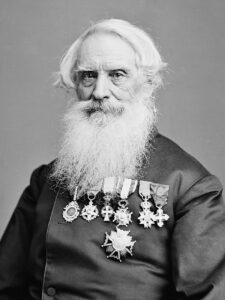 When we hear the name Samuel Morse, most of us might think of the Morse Code, and we would be right in thinking of that connection, but Morse would also be the inventor of Morse Code’s companion invention…the telegraph, which was debuted on January 6, 1838, at the Speedwell Iron Works in Morristown, New Jersey. His telegraph, a device that utilized electric impulses to transmit encoded messages over a wire, which ultimately revolutionized long-distance communication, achieving the peak of its popularity in the 1920s and 1930s. After that era, the telegraph, like most technology was outshined by the next big thing.
When we hear the name Samuel Morse, most of us might think of the Morse Code, and we would be right in thinking of that connection, but Morse would also be the inventor of Morse Code’s companion invention…the telegraph, which was debuted on January 6, 1838, at the Speedwell Iron Works in Morristown, New Jersey. His telegraph, a device that utilized electric impulses to transmit encoded messages over a wire, which ultimately revolutionized long-distance communication, achieving the peak of its popularity in the 1920s and 1930s. After that era, the telegraph, like most technology was outshined by the next big thing.
Samuel Finley Breese Morse was born on April 27, 1791, in Charlestown, Massachusetts. He was the first child of the Pastor Jedidiah Morse, who was also a geographer, and his wife Elizabeth Ann Finley Breese. He attended Yale University, where he developed an interest in both art and electricity, which was still in its infancy at the time. After college, Morse pursued a career as a painter. In 1832, while sailing home from Europe, he learned about the newly discovered electromagnet and conceived the idea for an electric telegraph. What he didn’t know was that other inventors were already working on that very concept. Samuel Morse married Lucretia Pickering Walker on September 29, 1818, in Concord, New Hampshire. She died on February 7, 1825, of a heart attack shortly after the birth of their third child. Their children were Susan born 1819, Charles born 1823, and James born 1825. He married his second wife, Sarah Elizabeth Griswold on August 10, 1848, in Utica, New York and had four children, Samuel born 1849, Cornelia born 1851, William born 1853, and Edward born 1857.
Morse dedicated the next several years to developing a prototype. He enlisted the help of Leonard Gale and Alfred Vail to aid him in the process. In 1838, he showcased his invention using Morse code, where dots and dashes represented letters and numbers. By 1843, Morse successfully persuaded a skeptical Congress to finance the construction of the first telegraph line in the United States, stretching from Washington DC to Baltimore. In May 1844, Morse sent the first official telegram over this line, with the message: “What hath God wrought!” That must have been an epic event in his life.
In the following years, private companies, utilizing Morse’s patent, established telegraph lines throughout the Northeast. In 1851, the New York and Valley Printing Telegraph Company was founded, later renaming itself Western Union. By 1861, Western Union had completed the first transcontinental line across the United States. Western Union is still in use today, mainly processing money transfers, but it’s likely they use more modern methods of processing their telegrams. Five years after the first transcontinental like was completed, the first successful permanent line across the Atlantic Ocean was constructed, and by the end of the century, telegraph systems had been established in Africa, Asia, and Australia.
Due to telegraph companies typically charging by the word, telegrams became known for their concise prose, regardless of whether they conveyed happy or sad news. The word “stop,” which was free, was used in place of a period, for which there was a charge. In 1933, Western Union introduced singing telegrams. During World War II, Americans grew to dread the sight of Western Union couriers, as the military used telegrams to inform families of soldiers’ deaths. It was efficient, but the sight of the couriers foretold the message all too often.
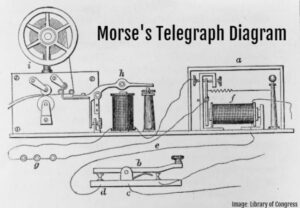
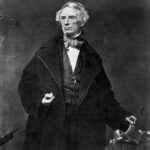 Throughout the 20th century, telegraph messages were largely replaced by affordable long-distance phone, faxes, and email. Western Union sent its last actual telegram in January 2006. That fact shows the versatility of the telegraph, and why it was such a great source of wealth for Samuel Morse. For this and other reasons Samuel Morse never lost his fame and popularity. He died of pneumonia, in New York City on April 2, 1872, at the age of 80. At the time of his passing, he was a wealthy man. His fame has long surpassed his years.
Throughout the 20th century, telegraph messages were largely replaced by affordable long-distance phone, faxes, and email. Western Union sent its last actual telegram in January 2006. That fact shows the versatility of the telegraph, and why it was such a great source of wealth for Samuel Morse. For this and other reasons Samuel Morse never lost his fame and popularity. He died of pneumonia, in New York City on April 2, 1872, at the age of 80. At the time of his passing, he was a wealthy man. His fame has long surpassed his years.
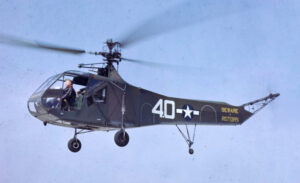
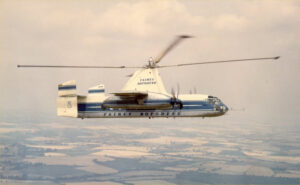 In 1942, the Sikorsky R-4 became the first helicopter to reach full-scale production. The creators had high hopes for the helicopter. They wanted it to become a mode of mass transit. Unfortunately, it just never caught on as a form of mass transit, not even when the Fairey Rotodyne came out. Nevertheless, it did receive one brave British attempt at that lofty goal.
In 1942, the Sikorsky R-4 became the first helicopter to reach full-scale production. The creators had high hopes for the helicopter. They wanted it to become a mode of mass transit. Unfortunately, it just never caught on as a form of mass transit, not even when the Fairey Rotodyne came out. Nevertheless, it did receive one brave British attempt at that lofty goal.
The Fairey Rotne was an unusual sight, seemingly blurring the boundaries of aviation. It looked like a half plane and half helicopter. Developed during the 1950s and early 1960s, in the early days of the helicopter, the United Kingdom hoped it would become a form of everyday transport. Of course, the intrigue of this helicopter is the fact that it can take off vertically using rotors with jets at their tips, but it was also powered forward by turboprops on the wing. The plan was for it to allow quick travel between cities and towns in the UK and around Europe. That dream was dashed when the project died an early death. The main problems were a lack of funding and concerns over noise.
Some people thought it was because the idea was “ahead of its time.” The idea just never too off, and orders were “hard to come by and interest faded.” I suppose that people just have a hard time accepting something new. Aviation can be even harder to accept new things with. I don’t know what kind of expense such “ride” would have been, but if it is anything like some of the little “hopper flights” from city to city, they are anything but cheap. That makes the use of a Fairey Rotodyne Hopper impractical.
The British project began in 1953 when the state-owned British European (BEA) commissioned the aviation firm Fairey to design a helicopter-type aircraft for commercial passenger. Henrich Focke, a German had developed the Focke-Wulf FW61, 17 years earlier. It was regarded as the world’s first practical helicopter, but even that one didn’t take off as a mass transport vehicle. BEA, which commenced small-scale services in 1950, sought an aircraft capable of taking off easily in urban areas and large enough to transport over 50 people swiftly to another location. The aim was to land in confined inner-city spaces and capitalize on the expanding European business travel market. Fairey introduced the Rotodyne, a composite helicopter that combines features of both an airplane and a helicopter. The Ministry of Supply supported the project by providing funding for its technical development. On June 16, 1959, it embarked on its inaugural international flight, traveling from Heathrow to Paris, with stops in Dover and Brussels. The journey to Brussels took one hour and 36 minutes, the leg from Brussels to Paris took 58 minutes, significantly faster than the alternative modes of transport such as ferry and train, or plane and car.
They gave it their best effort, but in the end, the project would simply not ever really take off. Some were shocked, saying, “This service will fly families out (and in) for holidays, take businessmen on business trips, 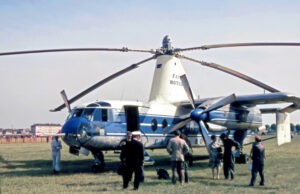
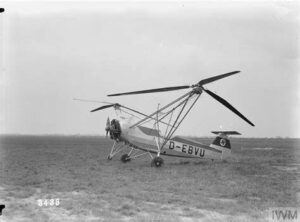 and increase the self-sufficiency of every busy provincial centre by providing the swift, direct communication nowadays so essential to the development of trade. Ever since helicopters were invented, there has been talk of rotary-wing services between city centres.” Nevertheless, despite the obvious thoughts by many that this would be a good thing, it just never got a good foothold, and eventually it failed.
and increase the self-sufficiency of every busy provincial centre by providing the swift, direct communication nowadays so essential to the development of trade. Ever since helicopters were invented, there has been talk of rotary-wing services between city centres.” Nevertheless, despite the obvious thoughts by many that this would be a good thing, it just never got a good foothold, and eventually it failed.
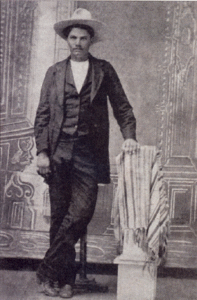 In many ways, life in the Old West was simpler and more peaceful, but when men mixed booze and gambling, tempers could flair. On January 4, 1870, a young man of just 16 years, named John Wesley Hardin got into a dispute with a man named Benjamin Bradley. The dispute was over a card game, and before it was over, Benjamin Bradley lay dead in the street, and John Hardin was a wanted man.
In many ways, life in the Old West was simpler and more peaceful, but when men mixed booze and gambling, tempers could flair. On January 4, 1870, a young man of just 16 years, named John Wesley Hardin got into a dispute with a man named Benjamin Bradley. The dispute was over a card game, and before it was over, Benjamin Bradley lay dead in the street, and John Hardin was a wanted man.
Hardin wasn’t the first man to end up in this predicament, and he wasn’t the most famous either. Far less famous than Billy the Kid, Jesse James, or Wyatt Earp, John Wesley Hardin is, nevertheless, believed to hold the gunslinger’s record for killing the most men in the shortest period of time. Bradley wasn’t even Hardin’s first kill. From the time Hardin first killed in 1868 until he shot his last victim ten years later, he is known to have murdered more than twenty men.
Hardin’s background as the son of a Methodist preacher would not normally have led him in the direction or murder, even though his father was a pro-Confederate, and therefore might have caused him to hold hard feelings toward northerners, but that still doesn’t explain the twenty killings. Nevertheless, he was an angry young man. He grew up in southeastern Texas. There, he learned to handle firearms by hunting and practicing his marksmanship using a target resembling Abraham Lincoln, whom he despised. Hardin’s violent tendencies emerged early when he stabbed a boy in the chest during quarrel over girl. Hardin was only 14 years old at the time of that incident. In 1871 Hardin married Jane Bowen (1856 – 1892). They had three children.
Hardin was a maniacal racist. He killed a former slave who threatened him with a stick. When three soldiers attempted to arrest him for the murder, Hardin shot them and fled to Navarro County, where he secured a position as a teacher in a one schoolhouse. His students were known as bullies who intimidated a series of teachers. Hardin discovered that carrying a revolver to class earned him the respect of even the most defiant scholars. Despite his gainful employment, Hardin was incapable of staying out of trouble. He claims that he went the tiny town Towash, Texas on Christmas Day 1869, seeking some companionship and a good game of cards. According to the East Texas Historical Journal, however, a contemporary El Paso newspaper places the date as January 4, 1870. Either way, Hardin apparently argued with James Bradley over a card hand.
According to Hardin’s account, that day, the two men faced each other on a deserted street in Towash, where Bradley fired at Hardin, but missed. Hardin then killed Bradley with two shots, one to the head and one to the chest. According to the news report, Hardin noticed money missing after the game and went out searching for another player named Moore. Along the way he met Bradley and shot him. It may never be known which of the 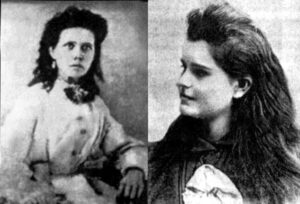 killing stories is true, but one thing is known for sure, Hardin left town and did not return.
killing stories is true, but one thing is known for sure, Hardin left town and did not return.
Although never tried for this murder, Hardin was later imprisoned for a shooting in 1878 and served 14 years. During his years of incarceration, his beloved wife passed. When Hardin finally emerged from prison in 1892, he declared himself changed man. He abandoned the violent ways of his youth and endeavored to live a peaceful life, raising his three children in Gonzales, Texas. Hardin’s past caught up with him three years later when a gunslinger shot him in the back in an El Paso bar. The killer was apparently trying to enhance his own fame as a gunman by killing the deadliest man in Texas.
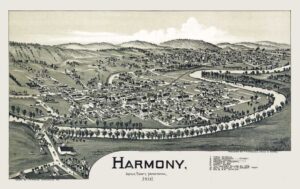
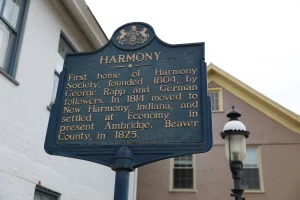 As the United States was being populated, people from many countries, of various religions and customs began to come. Many of these people came over together and built towns together. They felt like it was easier to live around people who had like beliefs and culture. One such town was that of the historic town on the Wabash River in Posey County, Indiana, called New Harmony. The town was founded by the Harmony Society in 1814.
As the United States was being populated, people from many countries, of various religions and customs began to come. Many of these people came over together and built towns together. They felt like it was easier to live around people who had like beliefs and culture. One such town was that of the historic town on the Wabash River in Posey County, Indiana, called New Harmony. The town was founded by the Harmony Society in 1814.
Known as the Rappites, the Harmony Society was similar to the Shakers in certain beliefs. The Harmony Society was named after their founder, Johann Georg Rapp. They had immigrated from Württemburg, Germany, to the United States in 1803, because like many immigrants to the United States, they were looking for religious freedom. George Rapp said in 1791, “I am a prophet, and I am called to be one.” After making that statement in front of a civil affairs official in Maulbronn, Germany, Rapp was arrested and imprisoned for two days. He was then threatened with exile if he did not cease preaching. It was a clear case of religious persecution.
The Rappites believed that the Bible was humanity’s sole authority. They also advanced celibacy and lead a communal life without individual possessions and believed that the harmony of male and female elements in humanity would be reestablished by their efforts. Upon immigrating to the United States, the society first established a colony in Butler County, Pennsylvania, called Harmony. There, George Rapp, also known as Father Rapp, was recognized as the spiritual head of the Society. Rapp’s adopted son, Frederick, managed the Society’s business and commercial affairs.
Under the leadership Frederick Rapp, Harmony’s economy evolved from a subsistence-based community to diversified manufacturing hub. By 1814, the had grown to 700 members and established town with approximately 130 brick, frame, and log houses, as well as numerous factories and processing plants. Their manufactured goods especially textiles and woolens, had a widespread reputation for excellence, along with their wines and whiskey
For a number of reasons, the Harmonists decided to leave Pennsylvania by 1814. The main reason for leaving was that the climate was really not suitable for growing grapes for wine. They also began to have difficulties with the new settlers to the area, resulting in less of their preferred isolation and increased land prices. The 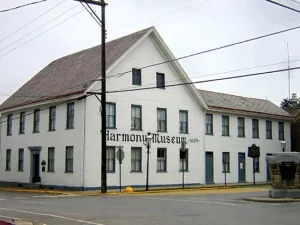 group leaders started searching for more land elsewhere. Soon they found land in Indiana that offered a better climate and room for expansion, so they set about planning to move. They sold their settlement to a Mennonite man named Abraham Ziegler for $100,000 and moved west.
group leaders started searching for more land elsewhere. Soon they found land in Indiana that offered a better climate and room for expansion, so they set about planning to move. They sold their settlement to a Mennonite man named Abraham Ziegler for $100,000 and moved west.
Their new location consisted of 3,500 acres along the Wabash River in Indiana. Their first year was plagued with sickness when as many of the Harmonists contracted malaria, causing work on the new town to nearly cease. As many as 120 individuals died from to the illness. Malaria persisted until Rapp ordered the drainage of the mosquito-infested lowlands surrounding the town. This new town was named Harmonie like their Pennsylvania settlement had been. Despite this early setback, the construction of the new town continued. Over the next decade, the society acquired additional land until they owned approximately 20,000 acres. By 1819, the Harmonites had constructed 150 log homes, a church, a community house, barns, stables, and a tavern, as well as established shops and mills and land for farming. They also started manufacturing at a larger scale than they had previously done in Pennsylvania. That year, the settlement boasted a steam wool carding and spinning factory, a brewery, a distillery, vineyards, and a winery.
Again, even though the community continued to thrive during the early 1820s, Frederick Rapp wanted a location better suited to manufacturing and commercial purposes. By 1824 the decision was made to sell their property in Indiana and search for land to the east. On January 3, 1825, the Harmonists sold their town to Robert Owen, a Welsh-born industrialist and social reformer, and his financial partner, William Maclure, for $150,000, and the society returned to Pennsylvania where they established another town. This town was called Economy. There, the Harmonists flourished, achieving their peak of prosperity in1866. However, the, the practice of celacy and schisms diminished the Society’s numbers, and the community was ultimately dissolved in 1905.
After the town was sold to Owen and Maclure, they renamed it New Harmony. Owen and Maclure had determined to create a new utopian community through free education and the abolition of social classes and personal wealth. William Maclure, who was a highly respected geologist, attracted many notable scholars to New Harmony… naturalists, geologists, educators, and early feminists. The town soon became known as a center for advancements in education and scientific research. The residents established the first free library, a drama club and a public school system open to both men and women. Even with all the seeming successes, Owen’s social experiment was an economic failure, and it was dissolved by 1827.
Today, residents and visitors appreciate the leisurely atmosphere of this vibrant community, where festivals, 
 concerts, and plays are held year-round. The is also a popular venue for weddings, conferences, and retreats. This unique rural village, now home to approximately 900 individuals, still showcases the simple wooden structures of the Harmonists. In 1966, the New Harmony Historic District was placed on the National Register of Historic Places, with a boundary increase in 2000.
concerts, and plays are held year-round. The is also a popular venue for weddings, conferences, and retreats. This unique rural village, now home to approximately 900 individuals, still showcases the simple wooden structures of the Harmonists. In 1966, the New Harmony Historic District was placed on the National Register of Historic Places, with a boundary increase in 2000.

 My nephew, Allen Beach and his wife Gaby moved to Oregon in 2023, in search of better opportunities. Now, about two years later, they love Oregon and have settled in nicely. They love to hike, and so they have explored some of the trails in the area. They also took a trip up the coast this past year and had a wonderful time. They have always loved to travel, and they took several trips this year…some weekends, and some longer. I suspect this year included so special trips, because on September 24, they celebrated their 10th wedding anniversary. Theirs is an interesting story. They met in the Navy, while stationed in Japan. Later, Allen proposed to Gaby in Bali. Then, before coming back to
My nephew, Allen Beach and his wife Gaby moved to Oregon in 2023, in search of better opportunities. Now, about two years later, they love Oregon and have settled in nicely. They love to hike, and so they have explored some of the trails in the area. They also took a trip up the coast this past year and had a wonderful time. They have always loved to travel, and they took several trips this year…some weekends, and some longer. I suspect this year included so special trips, because on September 24, they celebrated their 10th wedding anniversary. Theirs is an interesting story. They met in the Navy, while stationed in Japan. Later, Allen proposed to Gaby in Bali. Then, before coming back to 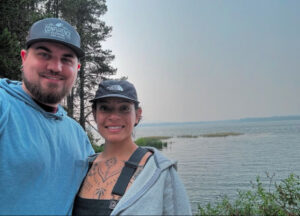 the states, Allen and Gaby were married in Japan.
the states, Allen and Gaby were married in Japan.
Since then, they have traveled to many places. They were stationed in Washington DC for a while, and they traveled to the Grand Canyon. They also traveled to Seattle, Washington to visit Allen’s dad, Warren Beach. They took a trip last year with Allen’s mom, Caryl Reed and Step-Dad, Mike Reed up the Oregon coast. They had a great time. The have taken several weekend trips to some beautiful spots, where Allen could use his love of photography to take 
 some great shots. Even their dog, Ollie got into some of the pictures. Ollie loved these trips. It was great fun.
some great shots. Even their dog, Ollie got into some of the pictures. Ollie loved these trips. It was great fun.
Allen is employed as a Care Management Associate for Aetna, collaborating with doctors to coordinate care plans that align with Aetna health insurance, which was acquired by CVS a few years ago. Allen works from home, which is a relatively new phenomenon that increased with the COVID-19 pandemic. Despite the newness of this arrangement, working from home is now considered a desirable job, and he thoroughly enjoys it. It is likely that his dog, Ollie, also loves the arrangement. Today is Allen’s birthday. Happy birthday Allen!! Have a great day!! We love you!!

